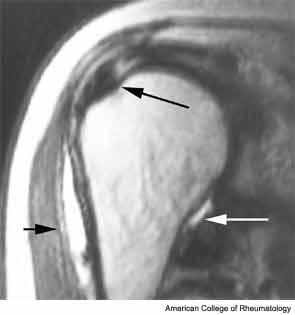
Shoulder pain is the third-leading cause for patients to seek musculoskeletal care.1,2 The impact of shoulder pain on health-related quality of life is also substantial. Shoulder pain accounted for $12 billion in direct healthcare costs in the United States in the year 2000. The etiology of shoulder pain includes rotator cuff tears, rotator cuff tendinopathy, glenohumeral arthritis, adhesive capsulitis, biceps tendonitis/tenosynovisits, acromioclavicular joint separation or degeneration, labral tears, and ligament tears. This review will differentiate the common causes of shoulder pain as well as explore the evaluation of shoulder pain by history, physical examination, and a brief overview of diagnostic testing.
History Elements
One of the most important aspects of history taking, especially relevant to rheumatology and physiatry practices, is to differentiate whether shoulder pain is the result of a primary shoulder pathology, cervical radiculopathy, a myofascial pain syndrome such as fibromyalgia or trigger points, or a systemic disorder such as polymyalgia rheumatica. The reader is likely familiar with systemic disorders leading to shoulder pain. Anecdotally, shoulder pain as a result of a primary shoulder disorder most often refers to the lateral aspect of the arm and can result in trapezial spasm when pain becomes chronic. One should suspect cervical radiculopathy if radiation is more extensive and involves the forearm and digits. This may be elicited by asking, “Does your pain travel from your neck into your shoulder (and fingers)?” A history of tingling and numbness in forearm and digits is also more commonly seen with cervical radiculopathy.
The location of pain is often not helpful in determining the etiology of shoulder pain. However, pain localized to the anterior aspect of the shoulder is often attributable to biceps tendonitis or biceps tenosynovitis. Pain localized to the superior aspect of the shoulder can be as a result of acromioclavicular joint pathology.
Once it is determined that shoulder pain is the result of a primary shoulder pathology, key history elements include whether the onset of pain was insidious and if there was an inciting event such as trauma or a fall. A fracture should almost always be ruled out in patients with a history of trauma. One has to be careful in judging whether an inciting event (as described by the patient) constitutes trauma. For instance, a patient may describe the onset of shoulder pain for the first time when they attempted to reach for an object in the backseat of a car while they were seated in the driver’s seat. Although this event may have set off a dormant rotator cuff tear, it is not a trauma/fall and has little relevance from a prognostic and/or treatment perspective. A “true” trauma includes falls, motor vehicle accidents, assault, and sports injuries. If surgery is indicated for the treatment of traumatic rotator cuff tears, an early repair is preferred to ensure optimal outcomes.3 Evidence to support this statement is, however, weak.
